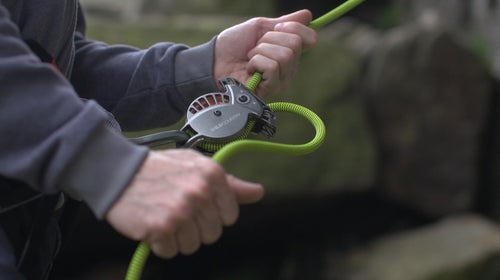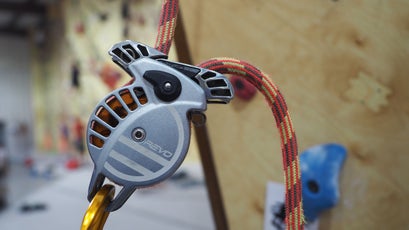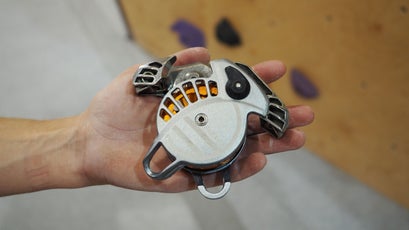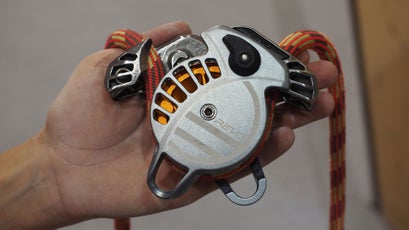“Ready to lower!” I yelled. As I descended from the anchor, my belayer dropped me faster and faster until I was free-falling. I expected—or hoped—the rope would go taut, but the ground came first.
My belayer was using a common tube-style belay device (one with no assisted braking). When he went to lower me, he had the brake strand of the rope flipped over the side of the device instead of properly through its front, friction-adding groove. The rope burned his hands, he instinctively let go, and I hit the deck from 40 feet up.
Luckily, I walked away with only sore legs and an achy back, but inadequate belays have caused 292 reported accidents in the United States between 1951 and 2015, across all experience levels, according to the annual report. The number of unreported accidents (mine included) is likely much higher.
Most belay accidents are caused by human error and are easily preventable. With that in mind, Wild Country released an innovative belay device, , which was designed to prevent the most common belay mistakes. The Revo is the first bidirectional belay device with a true auto-locking mechanism. I tested the Revo to see if it holds up to its claim as the “safest belay device on the market.”
How It Works
The Revo is essentially a tube-style belay device, but with an automatic backup similar to what you’d find on an assisted-braking belay device. While assisted-braking devices shy away from the term “auto-locking”—they use a camming mechanism or a carabiner and pinch point to add increasing friction to the rope, hence the name “assisted braking”—the Revo actually locks.
A grooved wheel sits within an aluminum housing, similar to a pulley, with two stainless-steel “jaws,” or grooved channels, on top of the device at the climber and brake sides of the rope. But this is no normal pulley. The grooved inner wheel the rope sits on and moves along as you take in and feed out slack (an “inertia reel,” as Wild Country calls it) locks at a speed of 13.1 feet per second—similar to the way a car’s seatbelt functions.
When the reel locks, the rope jams into its tapered grooves. At the same time, the brake-hand side of the stainless-steel jaws pops up. This increases the friction on the rope, preventing it from moving through the device and the climber from plummeting to the ground.
It’s not instant, however. By the time the falling climber reaches triggering speed and the inertia wheel activates and grips the rope (within one revolution of the reel), up to 3.6 feet of rope can pass through the device—on top of the distance of a leader fall and rope stretch. That’s potential for a pretty big whip—or even decking.
That said, a belayer using proper technique will never trigger the locking mechanism—it serves purely as a backup. You’d need to mess up for it to kick in, like if you let go of the brake strand during a fall or while lowering. The Revo’s braking mechanism also cannot be overridden like it can on other assisted-braking belay devices. The Revo is as foolproof as a belay device can get. To unlock the device, all a belayer must do is bring the rope back to the proper locked-off brake position, with the brake strand of the rope pulled down through the jaw’s groove. The brake strand pushes the jaw back down and resets the device.
Field Test
While the Revo’s inner workings may seem complex, using it is intuitive and requires the same belay technique as a standard tube-style device, such as an ATC.
Loading the Device
Threading the Revo is easy enough. A small lever on one side of its body unlocks and allows the housing to swivel open from 12:00 to 2:00. You can then thread a bight of rope around the wheel inside and up through the jaws. The Revo handles a wide range of rope diameters, from 8.5 to 11 millimeters (the same as Petzl’s popular assisted-braking ).
A huge safety perk is that you cannot load the device backwards. It works in either direction—something no other assisted-braking belay device does.
Belaying
The Revo is the smoothest belay device I’ve tested, and I’ve tested a hell of a lot of belay devices over the years in my previous life as an editor at Rock and Ice. Its inertia reel eliminates friction within the device and makes the task of giving and taking slack effortless. You can feel the difference when top-rope belaying, but lead belaying is where the Revo really shines.
Unlike most assisted-braking belay devices, the Revo has no camming mechanism that needs to be suppressed to feed out slack. As a belayer, that means both hands never leave the rope and you never have to fiddle with the device itself. This eliminates the possibility of overriding the braking mechanism and dropping a climber—a common cause of accidents with other assisted-braking belay devices.
With the inertia reel, I expected it would be easy to short-rope the climber, as in accidentally triggering the locking mechanism when attempting to feed out slack quickly. But in testing the device, I could yard out a full armload of slack with no problem. I had to try to lock the device. The inertia reel only kicks in well above the speed you feed out slack, even when the climber’s reaching for a quick and panicked clip.
Catching falls is no different than with a tube-style device, with the added safety that if you mess up, the inertia wheel’s got your back. As mentioned earlier, the auto-locking mechanism serves purely as a backup and does not provide any belay assistance, like the camming action of a GriGri. It’s all or nothing.
Unfortunately, the Revo cannot be locked manually when the climber is weighting the rope. This isn’t ideal for belay slaves who spend hours at attention while their partners work a project and milk every hanging rest. The belayer must keep a tight grip on the rope the entire time, like when using a tube-style device, as opposed to an assisted-braking belay device that, while not completely hands-free, does the lion’s share of the work. Using an assisted-braking belay device, a belayer can relax his grip and free a hand to fix a harness wedgie or to grab a snack.
Lowering
There is no handle or lever on the Revo for lowering like there is on something like a GriGri. You lower a climber just as you would with a tube-style device by keeping both hands on the brake strand of the rope, below the device, and controlling the rope’s speed as you let it feed through the device. This eliminates yet another avenue to common belay accidents, such as a belayer accidently cranking down on a device’s lowering lever, fully releasing the camming action, and dropping the climber. Last year, Petzl introduced a “panic-proof” lever on GriGri+ to mitigate this issue; Wild Country ditched the lever altogether.
Or, in the case of my accident, the belayer dropped me by letting go of the brake strand.
To test the Revo’s auto-locking mechanism in this scenario, I simply let go of the brake strand as well (with a backup knot, of course). The inertia wheel quickly kicked in and arrested the fall as advertised. The climber fell three to four feet before the device caught, which is not ideal had there been a ledge below, but mind you, I had to already “mess up” to trigger the automatic backup—and a fall of a few feet is much better than a ground fall.
Rappelling
As with the GriGri, the Revo can only be used for a single-rope rappel, just using the same technique as a tube-style device. The caveat, however, is that high on a rappel, the weight of the dead rope can be enough to disengage the Revo’s jaw had the locking mechanism been triggered. This nullifies the automatic backup.
If you happened to let go of the brake strand on rappel, for whatever reason, you probably wouldn’t hit the ground, since the device would likely catch lower down, but you could come in hot to a ledge.
Limitations
While the Revo functions like a tube-style belay device in many ways, it does have a few limitations beyond rappelling. First, the device can only be used with a single rope, so one cannot belay with a twin or double rope, a common practice on long or wandering trad, alpine, and ice routes.
Second, the device cannot be used to belay from above, directly off an anchor like an or GriGri can on multipitch and top-belay climbs. To belay from above with the Revo, one must belay off his or her harness and redirect the climber’s side of the rope through a carabiner above.
Finally, the device’s complicated mechanics are susceptible to freezing—the device can jam with snow or ice—so it’s not a good choice for winter climbing.
How the Revo Stacks Up
Overall, the Revo’s complexity simplifies belaying. While one could argue that all belay devices are equally as safe when used properly, the Revo makes it nearly impossible to mess up—and that makes it the safest belay device on the market.
But like all specialized gear, the Revo excels in a limited range of use. On multipitch, ice, or alpine routes and for long project sessions, the Revo’s limitations begin to outweigh its benefits—and it’s heavy, at 9.7 ounces. I’d stick to the lighter (3.1 ounces) and more versatile ATC-Guide for ice, alpine, and multipitch routes, and the GriGri will remain my weapon of choice for long project sessions. For single-pitch routes, whether at the climbing gym or crag, however, nothing can match the Revo.
While the Revo is intended for beginner and expert climbers, newer climbers will get the most out of it. The Revo enforces proper belay technique with the added safety of the automatic backup. Experienced climbers and guides who climb frequently with new climbers will also enjoy the added peace of mind that comes with the backup. In either case, the Revo eliminates pathways to common belay mistakes and minimizes the chances of an accident.
The everyday climber, those who enjoy casual days at the crag, shouldn’t feel left out either. The Revo is so smooth to belay with that you can forget about belayer’s arm and conserve strength for sending. Sure, it’s a bit heavy, bulky, and expensive, but the Revo is the most foolproof belay device available.
If my belayer had been using a Revo that day, he wouldn’t have dropped me.






